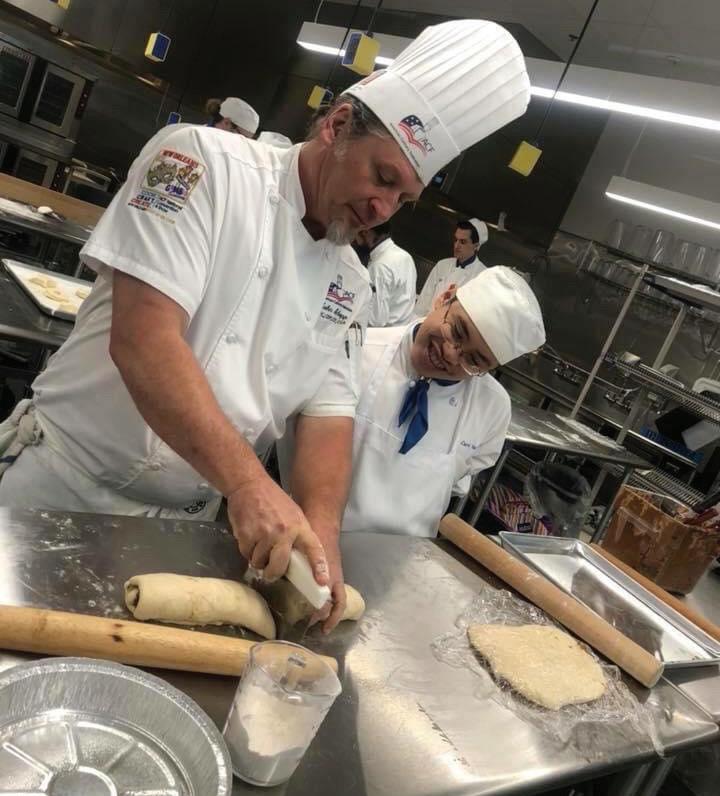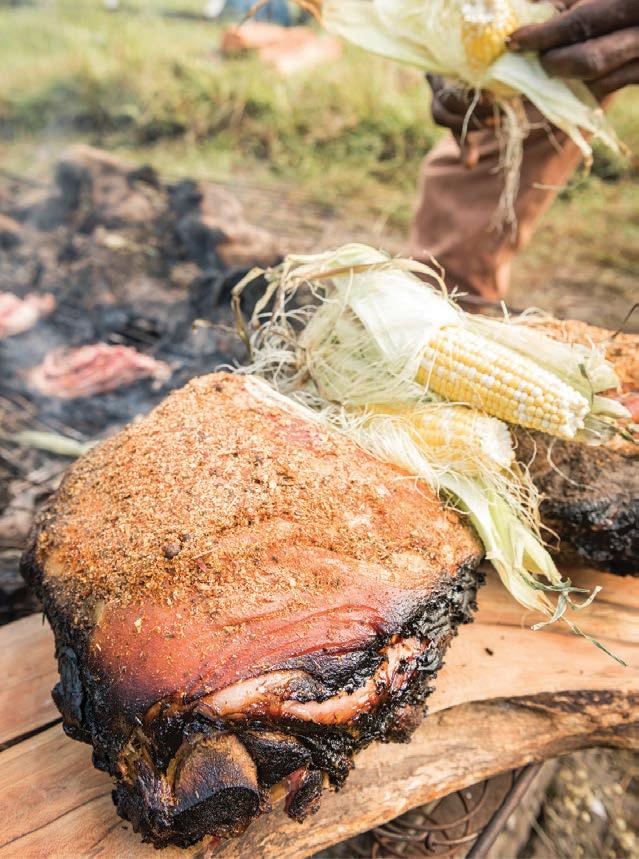
12 minute read
Management
from National Culinary Review (Nov/Dec 2021)
by National Culinary Review (an American Culinary Federation publication)
MANAGING HIGH VOLUME TODAY
University, health care and country club chefs share solutions that address labor shortages while meeting production needs // By Jody Shee
Nowadays you send out a want ad, and you’re lucky if anyone responds. Of those who do, only a few meet your hiring criteria. You set up two interviews, and neither person shows up. This dilemma compounds for high-volume foodservice operations such as universities, health care settings and country clubs. Not only that, but even tenured employees are bailing from the industry.
“A lot has to do with COVID,” says Chef Kristofer Jubinville (above), executive sous chef for Spring Run Golf Club in Estero, Florida. He knows of a sous chef at a fivestar restaurant now working in heating, ventilation and air conditioning for $30 an hour with no nights, weekends or holidays. The pandemic shutdown allowed him to step away from the restaurant hustle and bustle, and he’s not going back.
HIRING AND RETENTION TRICKS
Spring Run Golf Club, which averages 350 to 500 covers a day in peak season (January through May), along with banquet operations, offers employees a cash reward for newhire referrals who stay with the club at least 90 days, Chef Jubinville says.
More substantially, country club members formed an employee retention committee a few years ago. “Club members like to have the same person wait on them each time they dine,” Chef Jubinville says. Thus, the committee meets monthly to discuss ways to help retain these now-familiar employees, many with large families who sometimes share homes.
The committee has organized food drives for the employees, as well as backpack giveaways for their kids at the beginning of the school year. The committee also assembles Thanksgiving boxes with holiday groceries, including turkey and stuffing, and surveys employees to find out their children’s needs — be it a laptop, bicycle or school supplies. The committee then raises funds from among club members to purchase those items. “This committee always brainstorms ways to engage our staff so that they feel loved and wanted and make them not want to leave,” Chef Jubinville says. During high season (October through May) at Jonathan’s Landing Golf Club in Jupiter, Florida, management relies on international workers hired through Peter Petrina of Petrina Group International in Ithaca, New York. “If we depended on local staff, we’d be closed,” says Chef Joseph Watters, CEC (left), the club’s executive chef. In high season, the club operates three restaurants, banqueting services, a buffet kitchen and two snack bars. Events, tournaments and two clubhouses 13 miles apart compound the labor needs.
This year, the far-flung international workers arrived in October from Jamaica, Romania, Mexico and the Philippines — 15 to serve in front-of-house and 22 in back.
“(Petrina) does the interviewing to create a pool of cooks and servers to facilitate the club’s needs,” Chef Watters says. The workers arrive on a three-year work visa to handle the club’s high season, then move up north to work at another club for the rest of the year during their high season, then cycle back the next year, so they are available for three consecutive high seasons. For a nominal fee, the club provides the workers with an apartment or a room and valet transportation to and from work.
During the summer slowdown, a club near Jonathan’s Landing closes for the season, and Chef Watters takes on those employees, which also helps his labor needs.
OPERATIONAL OVERHAUL
Getting up to staff at Michigan State University in East Lansing this fall required some forethought, says Chef Kurt Kwiatkowski, CEC, CCA, AAC (opposite top), corporate executive chef. In a normal world, when school starts in the fall, student workers from the previous year resume where

they left off before summer break to staff the university’s nine dining units and 20 retail operations. But this year, a return from the pandemic hiatus meant hiring an entirely new and inexperienced crew of incoming freshmen. This unique labor crunch required a meeting of the culinary leadership team, including managers and executive chefs, to develop a labor prioritization plan.
“We looked at each operation and asked what we could do and do well if we were at 70% staffing,” Chef Kwiatkowski says. The team then developed plans for 60% staffing down through to 30% staffing. The answers went from closing platforms or venues to tightening and refocusing the menus. One adopted solution to help the dish-room dilemma was to use paper products to serve food until the new staff was up to speed.
To best utilize labor, the team also looked to quick-serve restaurants and street vendors for some fresh menu ideas and operational know-how. “In one platform, we had to think differently and throw away what we knew and what we had been doing and restructure for what we could pull off,” Chef Kwiatkowski says. Instead of offering a selection of several proteins and three sides and a sauce, the team scaled down the menu to include one protein, available in a grain bowl, as a salad or as a wrap. This allowed one person to batch cook the protein and come out and help the other worker serve it in whichever form the customer requested.

MENU AND PREPARATION SHORTCUTS For the sake of labor, menus and ingredients have come under the microscope and knife. This is especially true in health care for Chef
Timothy Schoonmaker,
CEC (left), corporate director of nutrition services, Centra Rosemary and George Dawson Inn, Lynchburg, Virginia. He has cross-trained his culinary team to handle multiple jobs at multiple outlets spread across 150 miles in various venues, including patient room service.
“We have a wide variety of menus and try to systemize everything as best as possible, which includes standardized recipes, technology, purchasing specs and equipment,” he says. In some cases, his team switched from all-scratch cooking to speed scratch — as in, mixes to make muffins, scones, biscuits, cakes and sauces. Chef Schoonmaker even purchases some items fully ready to eat, including macaroni and cheese, certain muffins and a few sauces and dressings.
With less labor available, some of the cafes Chef Schoonmaker oversees have closed some food stations and combined a few formats. “A great example is combining our salad bar/made-to-order salad and our healthy bowl program into one large format that has a combination of hot plant-based items, traditional proteins and both salad bar and bowl toppings,” he says.
While all these methods help the labor challenge temporarily, Chef Jubinville with Spring Run Golf Club believes it’s time to invest in youth, bringing younger workers into the industry, starting in high school and college. Of his own accord, he’s gone into a few schools to rustle up interest among students to come in as prep cooks.
“You leave behind your legacy. What are you leaving behind?” he asks. “You don’t leave your food behind, but young chefs who came up the right way and learned from you.”

High-Volume Equipment Standouts
The right equipment, often automated, reduces labor. Combi ovens are a valuable labor-saver for Centra Health in Lynchburg, Virginia, says Chef Timothy Schoonmaker, CEC, corporate director of nutrition services. “We cook our proteins overnight in the ovens, using a probe to cook and hold,” he says. The oven then retherms the cooked items. Additionally, for one of the hospital’s Meals on Wheels programs, a conveyor meal packaging system allows workers to fill containers with food and place them on the conveyor that seals and packages the meals. “We were able to move away from having three people preparing and packaging meals to one person,” he says.
The flexibility of the rapid-speed conveyor oven at Jonathan’s Landing Golf Club in Jupiter, Florida, helps to alleviate pressure on the line for certain hot items, Executive Chef Joseph Watters, CEC, says. He can program the time and temperature specifications for various items, like lobster rolls and flatbread, for example. With the machine’s conveyor belt system, the staff can manage the cooking of two items at once.
“When we put the flatbread in the [oven], we push the flatbread button. It controls the air flow from the top and bottom, the temperature and the cook time.” When the flatbread goes in, the lobster rolls shoot out the other end. The two items can jockey in and out with an automatic time and temperature recalculation. Because of the oven's catalytic converter, there’s no need for a hood, and thus the oven can go anywhere, Chef Watters says.
Jody Shee is a Kauai, Hawaii-based freelance writer and editor with more than 25 years of food-writing experience. She blogs at sheefood.com.
ATLANTA CHEFS ASSOCIATION
This ACF chapter puts a strong emphasis on parnerships within the industry, as well as on philanthropy and collaborative events // By Amelia Levin
The Atlanta Chefs Association (ACF-ACA) celebrates its 52nd anniversary this year servicing the Atlanta Metro area and most of the state of Georgia. At 250 members strong with more than 500 unofficial “members” (regular event attendees and allied partners), the chapter has been busier than ever during the pandemic. Most notably, chapter members and vendor partners teamed up to deliver thousands of meals to families and restaurant workers in need.
“Last year, we handed out just over 50,000 family meals,” says ACF-ACA President Nick Barrington, CEC, ACE, the executive chef at East Lake Golf Club in Atlanta, who is currently running for his second term as chapter president. “We fed everyone from veterans to first responders to families on the holidays. This year, we focused on transitioning to helping restaurants find chefs and purveyors.”
The chapter has also expanded its partnerships with other nonprofit organizations, including C.H.O.I.C.E.S., or The Center Helping Obesity in Children End Successfully. It was started by chapter member and 2020 ACF-ACA Humanitarian of the Year Ashley Keyes in an effort to drum up more awareness in the fight against childhood obesity. Most recently, Chef Keyes’ community outreach landed her a spot as one of the Walt Disney Company’s 50 Magic Makers.
Almost all of the funds raised by ACF-ACA go to Giving Kitchen, which provides financial relief for restaurant workers and families who are in need for a number of reasons, including illness, loss of work and loss of business due to fires, floods or other natural disasters. Part of the proceeds from an upcoming golf tournament hosted by ACF-ACA will go to the charity, which, in addition to offering relief for workers, recently teamed up with doctors and nurses who donated their time to offer free medical checkups and COVID-19 vaccines.
Giving Kitchen referred program participants in need of groceries and meals to ACF-ACA. “We would have cars and cars lined up to receive food and had to have police officers come direct traffic,” Chef Barrington says.

ACF-ACA President Nick Barrington presents the Humanitarian of the Year Award to Chef Ashley Keyes for her work in combattting childhood obesity.
The chapter relied on longtime partnerships with vendors and food suppliers for food donations and other connections. Equipment partner TriMark supplied the chapter with bags and boxes, while US Foods and Sysco donated refrigerated trucks to move the food. Chapter members also partnered with local YMCAs to feed people at the local level, especially in hard-hit communities.
What Chef Barrington says is most unique about ACF-ACA is that “we try to do things outside of the box so that we’re maintaining an impact in the community. Our tag is ‘Uniting Atlanta’s Culinary Community,’ and that’s what we do — we try to connect restaurants, chefs and companies.” The aforementioned partnerships set the chapter apart.
“We don’t have ‘sponsors.’ We have ‘partners,’” Chef Barrington says. “We have 18 going on 19 partners now. We help each other out; it’s not a one-way street. We help connect our partner companies with welltrained chefs, and we celebrate the accomplishments of everyone in our chapter, from students to master chefs."
The chapter even maintains a free online job posting forum on its website. “We placed two chefs just today,” Chef Barrington says.
Most recently, the chapter has begun to ramp up events, at least outdoors. This past summer, the chapter held a burger bash with corporate chefs from area suppliers. About 160 people attended, and Chef Barrington says the chapter gained six new members as a result.
ACF-ACA Executive Director Polly Barrington says videos are the next wave of efforts. “Between myself and a few board members, we take 300 pictures per event, and I’ll put them together in a three- to five-minute video that everyone loves to watch,” she says. The group also takes footage at all demonstrations and plans to do more with the medium to support the chapter’s active social media presence.
“We want to create an atmosphere that’s not a typical meeting where you sit down and watch someone demo, but rather have more interactive events to keep everyone engaged,” Chef Nick Barrington says. This is especially helpful for the chapter’s goal of engaging more students.
“We network with close to a dozen schools in the Atlanta area and make sure we are there to support them,” Chef Nick Barrington says. “We plan to dedicate two events this upcoming year to students and in October will be partnering with Boar’s Head to do a student sandwich showdown.” Atlanta is the host city for the SkillsUSA finals for the next five years.
“Our chapter message to younger chefs is that they have the power,” Chef Nick Barrington says. “Before the pandemic, it was difficult to find jobs and employers, but that’s flipped now. There is a bigger opportunity for young chefs right now that is unprecedented.”
Polly Barrington points out that this year, student members will have the opportunity to apply for grants to go to the 2022 ACF National Convention for free. “We found that students seem to be more excited about an all-expense-paid trip to an experience, rather than just money applied to their tuition, which they don’t really ‘see,’” she says. “Having that experience and coming back from it is like a walking billboard for ACF. We feel our chapter is leading the way in community involvement, member and partner engagement. In 2022, we will be partnering with other chapters in Georgia for monthly meetups and field trips. We’ve found we are stronger together, so we’re trying not to lose that momentum. Let’s all keep moving forward!”
Amelia Levin is the editor-in-chief of the National Culinary Review.











